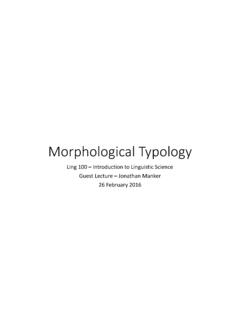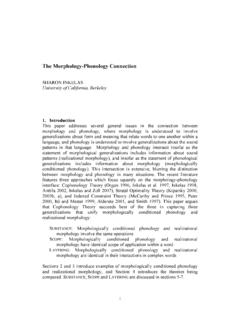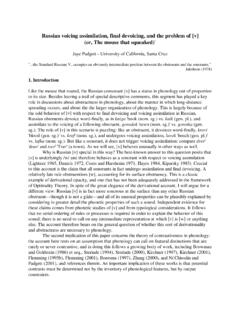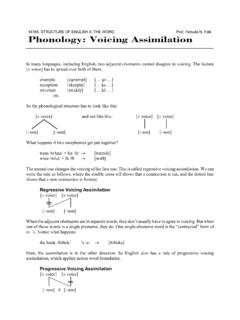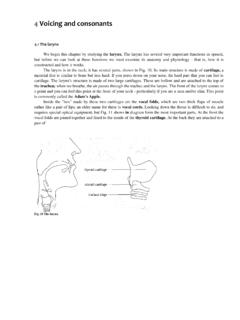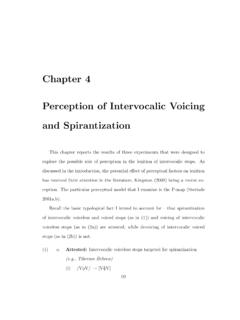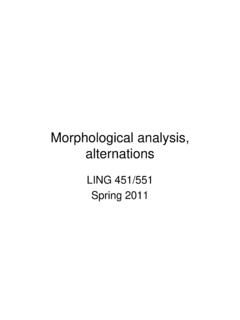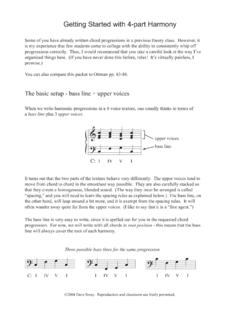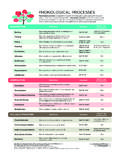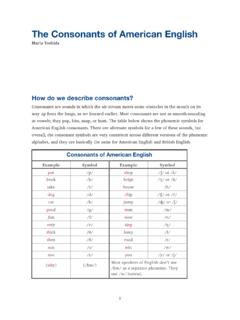Transcription of Phonetic Sources of Morphological Patterns in Sound …
1 Phonetic Sources of Morphological Patterns in Sound Change: fricative Voicing in athabascan jonathan Manker University of California, Berkeley While most modern athabascan languages are described as having contrastive voicing in fricatives, the Patterns of fricative voicing still follow both transparent and sometimes more complex Morphological (as well as phonological) environments. While a synchronic analysis of the language seems to demonstrate a direct connection between phonological Patterns and morphology, such an analysis may also suggest the possibility of Morphological conditions in Sound change, which has been proposed by some (Crowley 1997, Donohue 2005). This paper investigates the development of fricative voicing in two athabascan languages and demonstrates that purely Phonetic conditions can be identified that led to what appears to be a case of a morphologically conditioned Sound change, following a similar analysis in Blevins & Lynch (2009).
2 Both class-specific affixation and prominence Patterns are shown to provide Phonetic environments that may result in synchronic phonological Patterns following Morphological environments. 1. IntroductionEarly models of linguistic organization suggest the impossibility that non- Phonetic factors (morphosyntax, semantics, etc.) can influence Sound change. For example, the Neogrammarians proposed that Sound change is a purely Phonetic process, occurring under strictly Phonetic conditions (Bloomfield 1933:364, concerning the Neogrammarians). The American structuralists (Hockett 1942, Trager & Smith 1951) similarly proposed that different levels of linguistic organization, such as phonetics , morphology, and syntax, were considered to be autonomous modules, and thus Phonetic properties could not be influenced by factors such as part of speech, grammatical function, or semantic class.
3 Opposition to these claims existed throughout the first half of the 20th century despite their seemingly widespread acceptance. For example, Sapir UC Berkeley Phonology Lab Annual Report (2015)243 challenged the purely Phonetic model of Sound change, stating that the contemporary notion of independence between phonetics and grammar was unfortunate and that [t]here are likely to be fundamental relations between them and their respective histories that we do not yet fully grasp (Sapir 1921:183). Melchert (1975) categorizes several examples of Sound changes reported to have non- Phonetic conditions into two groups, those with functional conditions and those with frequency conditions. Those with a functional condition are typically Sound changes which have been initiated through Phonetic means, but seem to be blocked in certain morphemes in which, by applying the change, a morpheme may be ambiguously realized or lost entirely.
4 Most of these examples involve deletions, where superfluous Phonetic material is lost and functionally important elements survive (Melchert 1975:138). For example, some studies of alveolar stop deletion in word final clusters in various dialects of English (Fasold 1972) have shown that deletion occurs less frequently with /t/ and /d/ segments marking past tense, since it has an important grammatical function. Secondly, frequency is a condition which may license the spread of an otherwise phonetically-conditioned Sound change. Typically, frequency-conditioned Sound changes involve deletion or reduction and are restricted to high frequency words. The theory of lexical diffusion as formulated in Wang (1969) suggests that Sound changes may originate in just a few words but then may gradually diffuse throughout the lexicon. Bybee (2001), expanding on this theory, argues that frequency may be a contributing factor to this spread of a Sound change.
5 In this case, a Sound change may occur first in high frequency words and spread to words of similar frequency, even within sets of words with similar phonological characteristics. UC Berkeley Phonology Lab Annual Report (2015)244 An additional non- Phonetic factor in Sound change may be class conditioning, which is the primary focus of this article. A class conditioned Sound change is one in which a Morphological (stem or affix) or lexical (noun, verb, adjective, etc.) class licenses or blocks the spread of a Sound change. Some studies (Phillips 2006, Brown 2013, Bybee 2014) have investigated examples of word class conditions on the diffusion of Sound change. For example, Phillips (2006) shows different rates of change for the diphthongization of Dutch /ij/ or the laxing of English /u/ to / / throughout different word classes. Brown (2013) and Bybee (2014), however, suggest that there may be an effect of frequency in a favorable context for a particular Sound change whereby a Sound change is adopted in a word if it tends to occur in the particular Phonetic environment that may conditions the change.
6 Since different word classes may occur with different frequencies in the environments of certain words, this may provide an alternative account of this class-conditioned phenomenon (for further discussion see section ). Distinct from these cases, however, are more exceptionless, Neogrammarian style Sound changes in which the change is always licensed in certain word classes, but fails to ever occur in other word classes. Perhaps the best-known example comes from English in the development of the voiced interdental fricative / / in word onset position. As shown in table 1, / / has developed in onset position for all determiners and pronouns (no English pronouns or determiners begin with / /), as well in typically mono-morphemic or non-derived adverbs. On the contrary, / / resisted becoming voiced in onsets of nouns, verbs, adjectives, and prepositions, as well as in adverbs derived from adjectives. UC Berkeley Phonology Lab Annual Report (2015)245 / / / / Determiners: the, this, etc.
7 Nouns: thistle, thorn, etc. Pronouns: they, thy, etc. Verbs: think, throw, etc. (Certain) Adverbs: then, thus Adjectives: thin, thick, etc. Prepositions: through, (Certain) Adverbs: thinly, thickly Table 1: Development of the voiced interdental fricative in English onsets As with the pattern of onset / /, there are no exceptions for onset / / (for example, nouns beginning with / /), so it would seem reasonable, based on the synchronic pattern observed, to consider that the conditioning environments of the voicing change were the grammatical categories determiners, pronouns, and adverbs, or that there was a voicing faithfulness constraint that referenced lexical class information, being specified only for content words categories (FAITH(VOI)CONTENT). Other examples of exceptionless Sound changes with class conditions have been cited as cases demonstrating the effect of morphology on phonetics .
8 For example, Crowley (1997) argues against the strict separation of levels of the Structuralists, and demonstrates an example of Sound change with grammatical conditioning (244), in which a process of /l/ deletion is blocked in verbs. These examples and others will be more closely examined in section This paper details an example of what would appear to be a case of both Morphological and lexical class conditioning which occurs in the development of fricative voicing in pre-proto- athabascan and continued to develop in its daughter languages . This case looks similar to, but is UC Berkeley Phonology Lab Annual Report (2015)246 more complex than the example of interdental fricative voicing in English. In the athabascan case, onset voiced fricatives only occur in specific word and morpheme classes, and the presence of fricative voicing in affixes is also influenced by the position in the verb template. However, I will present substantial evidence showing that the Patterns of fricative voicing observed in modern athabascan languages are the result of Sound changes that had purely Phonetic motivations.
9 Both the Patterns of affixation unique to each word class and the Phonetic enviroments they tend to provide, as well as the prosodic Patterns of prominence which are mapped to different syntactic positions, will be considered as factors that influence the develop of fricative voicing. While this account may seem to follow a Neogrammarian approach of the strict separation between phonetics and grammar, it will instead detail the complex pathways and connections between phonetics and grammar, elucidating Sapir s fundamental that we do not fully grasp (Sapir 1921:183). Section 2 will provide background information about the two athabascan languages in this study, H n and Koyukon, including relevant aspects of their phonology and morphology. Section 3 provides phonetically-motivated explanations for Morphological Patterns and will demonstrate how these account for the athabascan data. Section 3 considers the Phonetic environments supplied by class specific affixation Patterns while section 4 shows how Patterns of prominence may lead to morphosyntactic Patterns of fricative voicing.
10 Section 5 will provide analysis and discussion and explores other extensions of this account in a broader prospective. Section 6 will conclude the article and consider future research which will address the remaining questions. UC Berkeley Phonology Lab Annual Report (2015)247 2. Background The athabascan Language Family The athabascan language family includes three major subfamilies, Southern (or Apachean, spoken in the American southwest), Pacific Coast (spoken along the coast of northern California and Oregon), and Northern athabascan , which includes the languages featured in this study. Northern athabascan is the largest family whose 23 languages are spoken across a massive territory stretching from western Alaska east to the Yukon and Northwest Territories, and further south in much of British Columbia and Alberta (Krauss & Golla 1981). Attempts to further subdivide the three major branches have been largely unsatisfactory (Krauss & Golla 1981).
